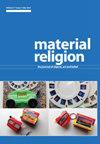American religion at The Met Cloisters
IF 0.4
3区 哲学
0 RELIGION
引用次数: 0
Abstract
Abstract This article traces the religious history of The Cloisters, the branch of The Metropolitan Museum of Art devoted to medieval European architecture and art in northern Manhattan, providing a case study of how Americans have used images of the medieval to articulate a moralistic American spirituality. It focuses on particular moments in the museum’s history—the 1914 museum created by sculptor George Grey Barnard; the 1938 opening of The Met Cloisters, funded by John D. Rockefeller, Jr.; its reception in the mid-twentieth century; a series of Episcopal Masses in the 1970s; and the spring 2018 exhibit Heavenly Bodies: Fashion and the Catholic Imagination—in order to unpack and contextualize the changes and constants in the visual vocabulary of religion at this museum. Throughout the twentieth century, founders, donors, curators, critics, and visitors saw a “right” way to respond emotionally to The Cloisters. One’s response to the museum demonstrated not only one’s sensitivity but also one’s character, especially the moral superiority of elite white Protestant men. In the twenty-first century, the design of Heavenly Bodies and its reception both drew upon and pushed back against the masculine Protestant paradigm of American medievalism that had long been established at The Cloisters.美国宗教在大都会修道院
本文追溯了位于曼哈顿北部的大都会艺术博物馆中世纪欧洲建筑和艺术分馆“修道院”的宗教历史,提供了一个美国人如何使用中世纪图像来表达美国道德主义精神的案例研究。它专注于博物馆历史上的特定时刻——1914年由雕塑家乔治·格雷·巴纳德(George Grey Barnard)创建的博物馆;1938年,由小约翰·d·洛克菲勒(John D. Rockefeller, Jr.)资助的大都会修道院(Met Cloisters)开幕;它在二十世纪中期的接受;20世纪70年代的一系列圣公会弥撒;以及2018年春季展览“天体:时尚和天主教的想象”——为了在这个博物馆中解开宗教视觉词汇的变化和不变,并将其置于背景中。在整个20世纪,创始人、捐赠者、策展人、评论家和参观者都看到了一种“正确”的方式来对《修道院》做出情感上的回应。一个人对博物馆的反应不仅表明了一个人的敏感,也表明了一个人的性格,尤其是白人新教徒精英的道德优越感。在21世纪,《天体》的设计和人们对它的接受,既借鉴了美国中世纪男性化的新教范式,也抵制了这种范式,这种范式在《修道院》中早已确立。
本文章由计算机程序翻译,如有差异,请以英文原文为准。
求助全文
约1分钟内获得全文
求助全文

 求助内容:
求助内容: 应助结果提醒方式:
应助结果提醒方式:


